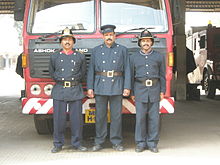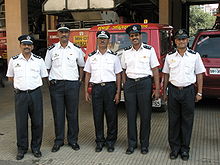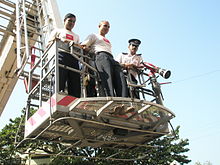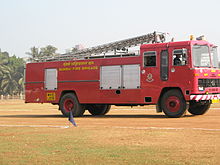- Mumbai Fire Brigade
-
Mumbai Fire Brigade 
Motto: "शौर्यम्, आत्मसँयमम्, त्यागः"
"Śauryaṃ, Ātmasaṃyamam, Tyāgaḥ"
(Sanskrit:"Valour, Abnegation, Sacrifice")Established 1 April 1887{{origins can be traced back to 1777}} Strength 2,700 Stations 33 Trucks 115 EMS Units 15 EMS Level BLS The Mumbai Fire Brigade (Marathi: मुंबई अग्निशमन दल) is responsible for the provision of fire protection in the City of Greater Mumbai as well as responding to building collapses, drowning cases, gas leakage, oil spillage, road and rail accidents, bird and animal rescues, fallen trees and taking appropriate action during natural calamities. It is the largest fire brigade in India[1] with 33 Fire Stations and 2700 personnel.
Contents
History
The origins of the Fire Service in Bombay can be traced back to 1477 when the locals were allotted Rs. 4 per day for handling different carts and horse chariots which were used to extinguish fire. Mumbai Fire Brigade is considered one of the finest in the world . In 1855, the Bombay Fire brigade started as a part time function of the Police and a regular fire service with horse drawn fire engines came into being in Bombay under control of the Commissioner of Police. In 1864, a commission was appointed to report the organisation of fire service and a Police officer was sent to England to qualify himself as Captain of the New sterm Fire Brigade. Bombay Fire Brigade was placed jointly under the Govt. and the Municipality in 1865. On 1 April 1887.[2] , the fire protection subject had passed on the Municipality. In 1888 Bombay Municipal Corporation Act was enacted and protection of life and properties from fire become the obligatory duty of the Corporation. W.Nicholls of the London Fire Brigade was appointed Chief Officer of Bombay Fire Brigade in 1890 and the management passed into hands of a professional fire fighting officer.[3] In 1907, the first petrol driven motor fire engine was imported and commissioned in Bombay fire brigade. W.J.Scllu of Bombay Fire Brigade joined Bombay Salvage Corps, Which was formed on 1 May 1907 with 37 insurance Companies. one of the prime objective of the Corps apart from salvage operation, was to minimise chance of fire. Street Fire Alarm System was first introduced in 1913. The Brigade was motorised by replacing the horse drawn steam engine in 1920 and the Bombay fire brigade started ambulance service consisting of six ambulances donated by Bai Jerbal Wadia and Sir Mangaldas Mehta.[4]
Post Independence
After Independence, in 1948, M.G. Pradhan was appointed Chief Fire Officer, the first Indian to hold this distinction. Since then the Brigade has been completely manned and controlled by Indians.
Jurisdiction & duties
The role and jurisdiction of the Brigade are set under the Maharashtra Fire Prevention and Life Safety Measures Act (2006).[5] Under the Act, the jurisdiction is set as the limits of Municipal Corporation of Greater Mumbai. Its role include:
- Promote Fire Safety; and
- To prepare for fighting fires and protecting people and property from fires; rescuing people from Road Traffic Accidents; and dealing with other specific emergencies, such as flooding or terrorist attack.
- Any activity which will help them meet their Statuatory Duties
Organisation
The Mumbai Fire Brigade has its City Headquarters in Byculla and Suburban Headquarters in Marol headed by the Chief Fire Officer. For operational purposes, Mumbai is divided into four regions. These are further divided in Divisions which is then further sub-divided in Sub-Divisions. Each Sub-Division has required number of Fire Stations as per need.
The Regions are each headed by a Deputy Chief (Fire). The Divisions are in the charge of Divisional Officers. Each of the Sub-Division is headed by the Sub-Divisional Officer. The Fire Station is managed by a Station Officer.
Hierarchy
Duty hours
When Mumbai Fire brigade started staff had 24 hour duty. They were provided quarters in premises of fire station. This virtually eliminated there personal life. Recently this rule was changed, now only officers have 24hr duty. Firemen have shift duty of eight hours. Few British rule are still prevalent like roll call is taken after every tea break, lunch break.
Daily Routine
Daily Routine is divided in four groups[6]
- Daily Routine
- Watch Room Function
- Fire Station Function
- Miscelloneous.
Daily Routine Procedure
Work, which includes general duty, maintenance of fire stations, operational work, drills and such other works carried out Round the clock every day and time to time.
- Rising Bell:- Rising Bell for personnel is given at 05:45 am. This bell also functions as a per-bell Alarm for the P.T. and Exercise.
- Bell for P.T.:- In order to maintain all personnel to be in physically good shape, Physical Training and Exercise are conducted early Morning at about 06:15 am to 07:10 am everyday (except Sunday)
This includes Running up to 02 km and different sets of exercise.
Watchroom's Function
- Duty Change:- It is shift change routine where personnel of the present shift take charge form the previous shift. This procedure is followed after the person's joining the duty and person's off the duty conducts 'Mount dismount' and every thing is checked according to Inventory List. Each shift is of 8 Hrs duty and in every shift these are about 9.10 personnel and every two person's take charge of Watch-room duty and Sentry-duty after every two Hrs. Duty/ shift change Timings :-07:00 Hrs to 15:00 Hrs – Ist. 15:00 Hrs to 23:00 Hrs – IInd 23:00 Hrs to 07:00 Hrs – IIIrd Shift.Work normally done by Watch-room and sentry duty personnel are as follows.
- Telephone Checking:- All the three Telephone Instruments are checked after every two Hrs and relevant entries are made in occurrence book. Any fault is reported to Fire Rescue Leader/ Officer-in-charge.
- Hand Over:- Take Over :- Duty Change of the two personnel working as Watch-room and Sentry by the next two personnel of the same which is done after the interval of two hrs.
- Night Round up:- Checking of Fire Station premise in order to see everything is sound and safe, usually done during Night/ Third shift and after every 1 Hrs.
Fire Station Functions
Routine followed every day to check and impact various appliances and equipments as well as maintenance of Fire Station Group.
- Fall-In:- In order to carry out different function, Fall-In is essential in which all personnel of that particular shift/ irrespective of the shift get-together.
- Fall in for Cleanliness/ Maintenance:- 08:00Hrs, all personnel fall-in to keep station ground clean, checking of appliances and equipments etc,.
- Fall in for Foot/ Fire Drill: – 08:30 Hrs to 10:00Hrs Foot Drill and Fire Drill (as per Drill Manual) is conducted everyday (except Sunday).
- Fall in for Maintenance/ Testing:- 15:00Hrs to 16.30Hrs -> Maintenance of all fire fighting equipments as well as testing of such equipment are done during these Hrs.
- Fall in for Roll Call:- 20:00Hrs. In order to check all personnel are present in station ground and to see personnel on leaves have joined duty and/ or to see which person is going next day leave etc,.
Miscellaneous
Other miscellaneous function as follows.
- Dismount:- 20:05Hrs :- Day called off after full day routine work.
- Bell Operandi:- Before each fall in, Warning Bell are given before is 15 minutes, in order to remain punctuate at exact fall in. Warning Bell and Fall in Bell is given by ringing such bell thrice sh/ off after Keeping constant for not more than 2 sec's.
- Date Change:- Date/ Day Change for next twenty four hrs at 00:00Hrs
Uniform
Fire brigade personals have three uniforms. Administrative uniform, Drill uniform and Fire fighting uniform. When attending a parade or any other ceremony, they are back in their blue uniforms with blue tunics and all their gallantry medals.[3]
Fire Fighting uniform
Mumbai Fire Brigade officials has dark blue tunic and pants. Blue keeps their body temperature constant (thus preventing them from catching fever) while fighting a blaze. The uniform includes a black waist-belt, a black helmet made from fibre reinforced plastic (in early days it was made from leather), and rubber shoes, which are fire-proof as well as chemical-proof. The uniform of the Mumbai Fire Brigade is distinctive. Fire Service Officers in other Indian States wear khakis. . Mumbai fire brigade personals use Merryweather type helmet. But now they are made of composite fibre
Administrative Uniform
At the office, taking care of administrative work, Fire Officers wear a different uniform with a white shirt, blue pants, peaked cap and black leather shoes. Firemen wear Sky blue shirt with bark blue pants and leather shoes. Firemen have Garrison cap and Driver, operator has Peaked cap.
Drill uniform
Firemen wear white T-shirts with MFB written on it and dark blue pants and leather shoes. Officers wear coat. Officers has to wear coat up to 8:45 am in morning, after that they change to Administrative uniform
Equipments
The fire stations are equipped with specialised equipment such as Fire Fighting and Rescue Vehicles, Ambulances, Breathing Apparatus Sets, Hydraulic Rescue Tools, electric chain saw, concrete or steel cutter, chemical protective suit, fire proximity suits, rescue rocket device, self/rope rescue devices and search camera.
Operations
Fire Safety Week
Fire Safety Week is held from 14 to 21 April every year, in honour of the 66 fire-fighters who lost their lives in the Bombay Explosion.[7]
2008 terrorist attacks
Title Note Chief Fire Officer Joint Chief Fire Officer Deputy Chief Fire Officer Divisional Fire Officer Assistant Divisional Fire Officer Station officer Assistant Station Officer Sub-Officer This article reads more like a story than an encyclopedia entry. To meet Wikipedia's quality standards and conform to the neutral point of view policy, please help to introduce a more formal style and remove any personally invested tone. (December 2010) Main article: 2008 Mumbai attacksOn 26 November 2008, the Mumbai Fire Brigade faced its greatest challenge, as terrorists attacked multiple high-visibility targets within the south city centre. The attacks took place in buildings which were frequented by foreign tourists. Among the buildings involved were the Taj Mahal Hotel, Hotel Trident , Chhatrapati Shivaji Terminus , the Leopold Cafe and Bade Miyan Gali.
In a well-planned series of simultaneous attacks, the terrorists used automatic weapons, hand grenades and C4 explosive with the intention of murdering as many as possible, taking hostages and igniting fires within the structures. The largest blaze was determined to be the one at the Taj Mahal Hotel, whose upper floors were well-inflamed.
With no sprinkler systems or interior standpipes, the fire-suppression effort was limited to a master stream attack from aerial devices such as the Bronto Skylift. Firefighting efforts were hampered by gunfire aimed at firefighters, who bravely remained at their posts both atop the aerial platforms and at the ground level. Many dozens of rescues and removals took place using additional aerial devices.
American businessman, C. Richard Diffenderffer, was just one of hundreds of trapped victims. In news accounts, he referred to Mumbai's firefighters as "angels from Heaven." As fire crews finally reached Diffenderffer, he said they surrounded him in order to protect him from gunfire.
“There were some pretty scary moments while we were fighting fires at the Taj Hotel. On Thursday night, while we were in a cage trying to rescue guests trapped in the heritage section of the hotel, we saw a gun-toting terrorist,” A.V. Sawant, Chief Fire Officer, said.
“Luckily for us, he did not turn in our direction and we continued fighting the fire,” Mr. Sawant said. The fire brigade was called in to battle fires multiple times at the Taj and Oberoi hotels.
“They [the terrorists] kept setting the rooms on fire while fighting the commandos. We would wait for an assurance from the commandos before going in,” Mr. Sawant said.
However, the sound of firing did not make it easy for them, he said. “It was not easy to work in such conditions. There is a risk while fighting fires but in this case there was the added risk of bullets,” a fireman said.
In the wake of the late November 2008 events, it was revealed that Mumbai's firefighters have poor personal protective gear. One fireman best described the brigades' Personal protective equipment (PPE) as similar to London's circa 1950. Members currently wear wool tunics and compressed cork helmets. State-of-the-art firefighting gear has apparently been authorised by the Municipal Corporation of Greater Mumbai but, 13 months later, front-line firefighting teams had yet to see these lifesaving garments.
Contact numbers
Hotline 101 (Unmetered Number)
Trivia
Majority of Fire Station has Ganesha temple. Because lord Ganesha is associated with coolness, and clearing obstacles. It is believed that due to cool nature of Ganesha it will shield Firefighter from heat of fire.
See also
Gallery
-
Close up of Hydraulic Platform
References
- ^ "Mumbai Fire Brigade to utilise Mercedes-Benz Actros trucks for special application". domain-b.com. 16 September 2009. http://www.domain-b.com/companies/companies_m/MercedesBenzIndia/20090916_mercedes-benz.html. Retrieved 5 December 2010.
- ^ http://www.mcgm.gov.in/irj/portalapps/com.mcgm.ahome_keyprojects/docs/2-8%20Fire%20Services.pdf
- ^ a b [1][dead link]
- ^ Fire services in India: history ... – Google Books. Books.google.co.uk. http://books.google.co.uk/books?id=nyokqAQOgMsC&printsec=frontcover#v=onepage&q=&f=false. Retrieved 5 December 2010.
- ^ "Microsoft Word - Fire Act Rules _English Final 06.01.2009_.doc" (PDF). http://maharashtra.gov.in/data/gr/english/2009/01/13/20090116122831001.pdf. Retrieved 5 December 2010.
- ^ http://midcfireservice.com/dailyroutine.html
- ^ "Welcome to Maharashtra Fire Services". Maharashtrafireservices.org. 4 January 2010. http://www.maharashtrafireservices.org/fire_service_week.htm. Retrieved 5 December 2010.
External Reference
Categories:- Fire departments
- Mumbai
- Fire departments of Asia
- Fire departments of India
- Organizations established in 1887
- 1887 establishments in India
Wikimedia Foundation. 2010.










